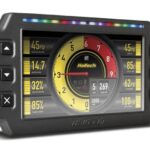Understanding your car’s health is now easier than ever with OBD2 scanners. These devices, paired with user-friendly apps like RepairSolutions2, empower car owners, DIY enthusiasts, and even seasoned technicians to diagnose vehicle issues effectively. Whether you’re just curious about a warning light or aiming to perform your own repairs, knowing how to use an OBD2 scanner is a valuable skill.
Decoding Your Car’s Language: OBD2 and Your Vehicle
OBD2, or On-Board Diagnostics II, is a standardized system in most modern vehicles that monitors various systems, from the engine to emissions. When something goes wrong, your car’s computer generates diagnostic trouble codes (DTCs). This is where an OBD2 scanner comes into play – it’s your translator for these codes, helping you understand what your car is trying to tell you.
Getting Started with an OBD2 Scanner
Using an OBD2 scanner is generally straightforward. Here’s a step-by-step guide to get you started:
-
Locate the OBD2 Port: The OBD2 port is typically found under the dashboard on the driver’s side of most vehicles. Consult your car’s manual if you are unsure of its exact location.
-
Connect the Scanner: With your vehicle turned off, plug the OBD2 scanner into the port. Some scanners are handheld devices, while others are dongles that connect wirelessly to your smartphone via Bluetooth.
-
Turn on the Ignition (but not the Engine): Turn your key to the “ON” position, which powers up your car’s electronics without starting the engine. This allows the scanner to communicate with the car’s computer.
-
Pair with an App (if applicable): If you’re using a Bluetooth OBD2 dongle, you’ll need to pair it with a compatible app on your smartphone or tablet. The RepairSolutions2 app, for example, seamlessly connects with compatible OBD2 scanners and dongles.
-
Start Scanning: Follow the scanner’s or app’s instructions to initiate a vehicle scan. Typically, you’ll find options to perform quick scans (engine only), scan specific modules, or conduct a complete network scan.
Understanding the Scan Results
Once the scan is complete, the OBD2 scanner or app will display any stored DTCs. Here’s what you can typically do with the results, especially when using an app like RepairSolutions2:
-
Lookup DTC Definitions: The app will provide definitions for the DTC codes, often in layman’s terms, making it easier to understand what the code means. RepairSolutions2 goes further by offering ASE-verified fixes associated with each code.
-
Assess the Effect on Your Vehicle: Understanding the potential impact of the issue is crucial. The app can often provide information on how a particular problem might be affecting your vehicle’s performance or safety.
-
Access Verified Fixes: Instead of just giving you a code, RepairSolutions2 provides verified fixes from ASE Master Technicians. This is a significant advantage as it directs you towards solutions that are known to work. This database is built upon nearly 30 years of collected vehicle data.
Advanced Features and What You Can Do
Beyond reading codes, many OBD2 scanners and apps like RepairSolutions2 offer advanced functionalities:
-
Live Data: Monitor real-time data from your vehicle’s sensors. This can be incredibly useful for diagnosing intermittent issues or understanding how different systems are behaving while the car is running. You can customize the data feed to focus on specific parameters and even record sessions for later analysis.
-
Scheduled Maintenance: Stay on top of your car’s maintenance schedule. RepairSolutions2 provides manufacturer-recommended maintenance schedules based on your vehicle’s history and OEM guidelines, including direct links to purchase necessary parts.
-
Predicted Repairs: Proactively plan for future maintenance. Advanced databases within apps like RepairSolutions2 can predict potential upcoming repairs, helping you budget and prepare.
-
Repair Scheduling: If you prefer professional assistance, RepairSolutions2 can help you schedule repairs at certified facilities through integrations like RepairPal.
Even Without a Tool: Vehicle Care Information at Your Fingertips
One of the notable aspects of apps like RepairSolutions2 is that you can access valuable vehicle care information even without owning an OBD2 scanner. You can typically look up:
- Warranty Status
- Scheduled Maintenance Information
- Technical Service Bulletins (TSBs) and Recalls
- 5-Year Cost to Own estimates
- DTC Code Definitions
This “no tool needed” access makes it a valuable resource for any car owner seeking to be more informed about their vehicle’s health and maintenance needs.
Conclusion: Empowering Car Owners with OBD2 Scanners
OBD2 scanners and companion apps have democratized vehicle diagnostics. They provide an accessible and user-friendly way for individuals to understand their car’s condition, troubleshoot problems, and make informed repair decisions. Whether you are a seasoned DIYer or a car owner looking to stay informed, learning how to use an OBD2 scanner and leveraging tools like RepairSolutions2 can save you time, money, and keep you confidently in the driver’s seat when it comes to vehicle maintenance.
